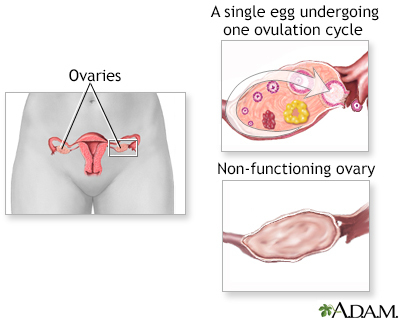Premature ovarian failure
Definition
Premature ovarian failure is reduced function of the ovaries (including decreased production of hormones). Ovarian failure that occurs before the age of 40 is considered premature ovarian failure.
Alternative Names
Ovarian hypofunction; Ovarian insufficiency
Causes
Premature ovarian failure may be caused by genetic factors such as chromosome abnormalities. It may also occur with certain autoimmune disorders that disrupt the normal function of the ovaries. Most often there is no obvious cause, although a family history of the condition may play a role.
Chemotherapy and radiation therapy can also cause premature ovarian failure.
Symptoms
Women with premature ovarian failure may develop symptoms of menopause, which include:
- Hot flashes
- Irregular or absent periods
- Mood swings
- Night sweats
- Vaginal dryness
This condition may also make it hard for a woman to become pregnant.
Exams and Tests
A blood test will be done to check your level of follicle-stimulating hormone, or FSH. FSH levels are higher than normal in women with premature ovarian failure.
A vaginal ultrasound may be done to check how many follicles the ovaries contain. Reduced numbers of ovarian follicles may occur in women who develop this condition.
Other blood tests may be done to look for autoimmune disorders or thyroid disease.
Women with premature ovarian failure who want to become pregnant may be concerned about their ability to conceive. Those younger than age 30 may have a chromosome analysis to check for problems. In most cases, older women who are close to menopause do not need this test.
Treatment
Estrogen therapy often helps relieve menopausal symptoms and prevents bone loss. However, it will not increase your chances of becoming pregnant. Fewer than 1 in 10 women with this condition will be able to get pregnant. The chance of getting pregnant increases to 50% when you use a fertilized donor egg (an egg from another woman).
When to Contact a Medical Professional
Call your health care provider if:
- You are no longer having monthly periods.
- You have symptoms of early menopause.
- You are having difficulty becoming pregnant.
Gallery

References
Broekmans FJ, Fauser BCJM. Female infertility: evaluation and management. In: Jameson JL, De Groot LJ, de Kretser DM, et al, eds. Endocrinology: Adult and Pediatric. 7th ed. Philadelphia, PA: Elsevier Saunders; 2016:chap 132.
Bulun SE. Physiology and pathology of the female reproductive axis. In: Melmed S, Auchus RJ, Goldfine AB, Koenig RJ, Rosen CJ, eds. Williams Textbook of Endocrinology. 14th ed. Philadelphia, PA: Elsevier; 2020:chap 17.
Douglas NC, Lobo RA. Reproductive endocrinology: neuroendocrinology, gonadotropins, sex steroids, prostaglandins, ovulation, menstruation, and hormone assay. In: Lobo RA, Gershenson DM, Lentz GM, Valea FA, Lobo RA, eds. Comprehensive Gynecology. 8th ed. Philadelphia, PA: Elsevier; 2022:chap 4.
Dumesic DA, Gambone JC. Amenorrhea, oligomenorrhea, and hyperandrogenic disorders. In: Hacker NF, Gambone JC, Hobel CJ, eds. Hacker & Moore's Essentials of Obstetrics and Gynecology. 6th ed. Philadelphia, PA: Elsevier; 2016:chap 33.
Lobo RA. Menopause and aging. In: Strauss JF, Barbieri RL, eds. Yen and Jaffe's Reproductive Endocrinology. 8th ed. Philadelphia, PA: Elsevier; 2019:chap 14.